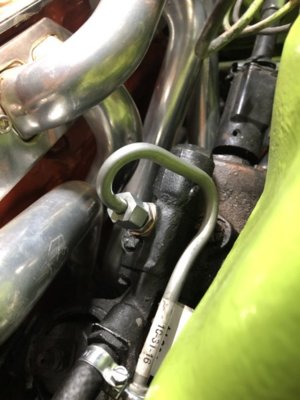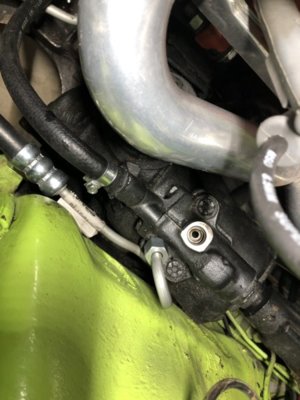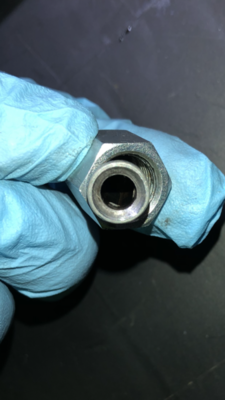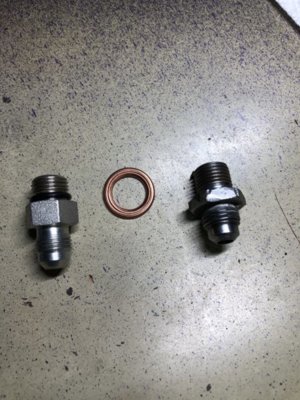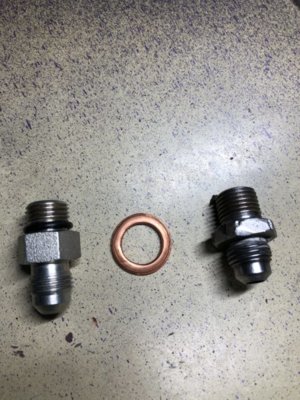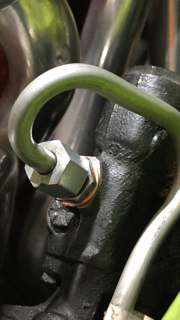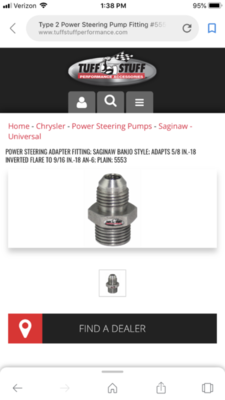You are using an out of date browser. It may not display this or other websites correctly.
You should upgrade or use an alternative browser.
You should upgrade or use an alternative browser.
Leaking compression fitting driving me nuts!
- Thread starter Moparfiend
- Start date
Also known as Belleville spring washers. I use them on electromagnetic lock armatures, where some play is is required to accommodate the gate closure movement. Shown below are the washers 'back to back' to give movement sideways.Ugggg WTF how many different kinds of crush washers are there lol. I guess I now need a lesson in crush washers 101 for idiotsGuess what I get when I searched for a Bissell waher lol
View attachment 730313
miller
Well-Known Member
All types of so-called Belleville washers. The ones shown are spring steel. Ones I pictured are soft copper. In the day, they were used many times to fix leaky fittings, usually brake systems.Also known as Belleville spring washers.
Lesson on 'crush' washers...real crush washers are filled with asbestos, that allow them to crush/go flat. Pretty sure the normal flat copper that goes under the fitting hex, is just that, a soft solid copper washer. The torque on it, makes it seal.
But, hey...any port in the storm, right!
I like this video. The flat side to the side that doesn’t spin.
https://video.eaa.org/detail/video/995217327001/crush-washers
https://video.eaa.org/detail/video/995217327001/crush-washers
Last edited:
Isn't done until its tested.Well that took five minutes of installation time and countless time understanding how to do this correctly! Thanks again guys! I have not pressure tested this yet but I am confident it will be good to go. The box shoulder cleaned right up with a rag with a bit of lacquer thinner.
View attachment 730799 View attachment 730801 View attachment 730804 View attachment 730805 View attachment 730806
I know....Isn't done until its tested.
dsd1967
Well-Known Member
I hope it works for you. I always assumed the crush washers (copper wrapped around a fiberous material) were for lower pressure applications such as oil pans. The ones I'm used to seeing for high pressure are solid copper.
After some research in gasket handbooks you may very well be correct. If this is an asbestos filled gasket (which I don’t know as I got it at Napa with no part number) then it WOULD have a 200PSI rating which is obviously not sufficient.I hope it works for you. I always assumed the crush washers (copper wrapped around a fiberous material) were for lower pressure applications such as oil pans. The ones I'm used to seeing for high pressure are solid copper.
Asbestos I don't think you can use anymore and sell new only old parts. You would see a seam in them, VWs used them.
There was a seem! As to its make up?Asbestos I don't think you can use anymore and sell new only old parts. You would see a seam in them, VWs used them.
No time to fire up for a while. I don’t want to start it up until I find the so
Thanks for asking!
Very busy with family so its going to be a few days or more like a week before I can get back at it. I’l Update here when I am able to fire the beast back up.So, how’d it go?
Thanks for asking!
steve340
Well-Known Member
Those seamed gaskets are for exhaust I think or drain plugs. However it might work.
Your steering will be about 800 to 1000 psi on the stops.
As someone mentioned earlier the original is solid copper more like a brake hose washer.
When I changed my pump from the Federal to the Saginaw the hose fitting went up a size on the steering box and I could not use my original fitting.
I used the hydraulic fitting you have pictured in an earlier post. It has the o ring on the threads.
The steering box actually has a small taper at the top of the threads if you look closely. A little steering fluid on the o ring to lube it and straight in no leaks all good.
Mine has not leaked a drop.
Your steering will be about 800 to 1000 psi on the stops.
As someone mentioned earlier the original is solid copper more like a brake hose washer.
When I changed my pump from the Federal to the Saginaw the hose fitting went up a size on the steering box and I could not use my original fitting.
I used the hydraulic fitting you have pictured in an earlier post. It has the o ring on the threads.
The steering box actually has a small taper at the top of the threads if you look closely. A little steering fluid on the o ring to lube it and straight in no leaks all good.
Mine has not leaked a drop.
Yeah the fuy at the fitting store said it was rated to 3000psi but the angle my not be 45 degrees as some here said it looked to be 37 degrees?Those seamed gaskets are for exhaust I think or drain plugs. However it might work.
Your steering will be about 800 to 1000 psi on the stops.
As someone mentioned earlier the original is solid copper more like a brake hose washer.
When I changed my pump from the Federal to the Saginaw the hose fitting went up a size on the steering box and I could not use my original fitting.
I used the hydraulic fitting you have pictured in an earlier post. It has the o ring on the threads.
The steering box actually has a small taper at the top of the threads if you look closely. A little steering fluid on the o ring to lube it and straight in no leaks all good.
Mine has not leaked a drop.
steve340
Well-Known Member
If the seat face is damaged on your original fitting it will probably leak. Check it carefully.
I do not know about the 37/45 thing. Never paid much attention to it.
The flare only needs to seal on a little ring of face so not to sure if it will be a problem.
Put a little anti-sieze on the flare fitting threads and a little dab of power steering fluid on the seal face area. Do not wiggle the pipe around if you damage the seat face it will leak.
The flare fitting can take a fair bit of torque. I use two spanners to get them tight.
Do not over tighten the fitting in the steering box by just screwing down with the flare fitting nut.
If it leaks crank it up more. If you cannot seal the leak replace both parts and start again.
The JIC fitting in your pic is designed for hydraulic manifolds or machinery. They are pretty bullet proof.
I do not know about the 37/45 thing. Never paid much attention to it.
The flare only needs to seal on a little ring of face so not to sure if it will be a problem.
Put a little anti-sieze on the flare fitting threads and a little dab of power steering fluid on the seal face area. Do not wiggle the pipe around if you damage the seat face it will leak.
The flare fitting can take a fair bit of torque. I use two spanners to get them tight.
Do not over tighten the fitting in the steering box by just screwing down with the flare fitting nut.
If it leaks crank it up more. If you cannot seal the leak replace both parts and start again.
The JIC fitting in your pic is designed for hydraulic manifolds or machinery. They are pretty bullet proof.
SAR is 45 degrees and JIC is 37 degrees. Soo most people agree they are not compatible which makes sense to me. I did notice the fitting has seen better days but am hoping for the best. Also I was not able to locate the correct SAE fitting anywhere.If the seat face is damaged on your original fitting it will probably leak. Check it carefully.
I do not know about the 37/45 thing. Never paid much attention to it.
The flare only needs to seal on a little ring of face so not to sure if it will be a problem.
Put a little anti-sieze on the flare fitting threads and a little dab of power steering fluid on the seal face area. Do not wiggle the pipe around if you damage the seat face it will leak.
The flare fitting can take a fair bit of torque. I use two spanners to get them tight.
Do not over tighten the fitting in the steering box by just screwing down with the flare fitting nut.
If it leaks crank it up more. If you cannot seal the leak replace both parts and start again.
The JIC fitting in your pic is designed for hydraulic manifolds or machinery. They are pretty bullet proof.
Similar threads
- Replies
- 58
- Views
- 2K
- Replies
- 6
- Views
- 1K

